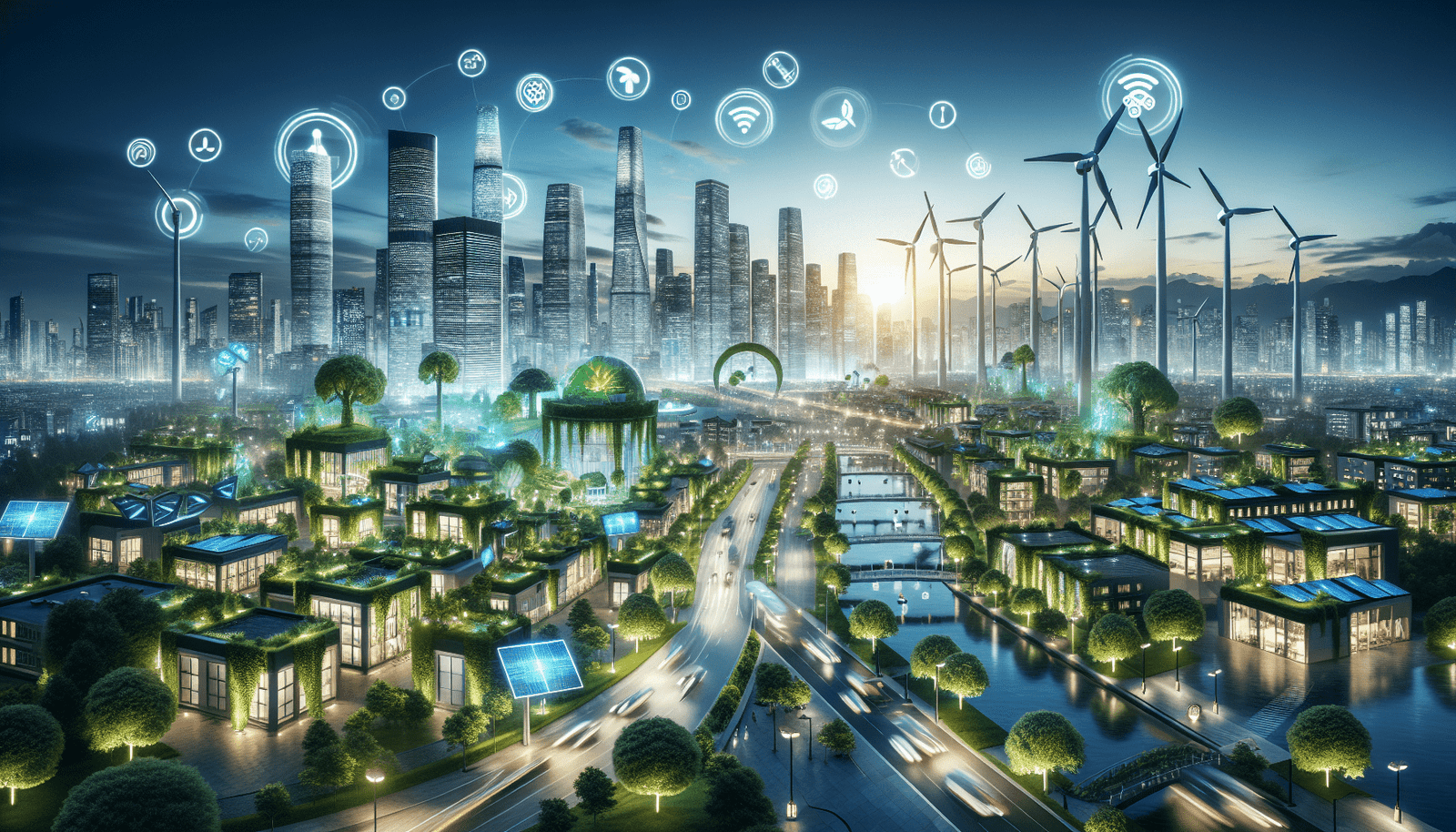What does it mean to live in a smart city? I often wonder how interconnected technologies can transform urban areas into more sustainable places for us to live, work, and play. As I think about my own experiences in cities, I recognize that the future of urban living is intricately tied to innovation and sustainability.
What Are Smart Cities?
Smart cities leverage technology and data to enhance urban functions, improve quality of life, and promote sustainability. I find it fascinating how the integration of sensors, the internet of things (IoT), and artificial intelligence (AI) can impact the way I interact with my surroundings. In essence, these cities utilize advanced technologies to optimize resources and services, making daily life more efficient.
Core Components of Smart Cities
Several key components make up a smart city. Each plays a crucial role in how urban environments function and how the quality of life for residents is enhanced.
| Component | Description |
|---|---|
| Infrastructure | Smart infrastructure includes roads, buildings, and utilities that are equipped with sensors and smart technology. |
| Transportation | Intelligent transportation systems optimize traffic flow and public transit. |
| Energy Management | Smart grids facilitate efficient energy use and renewable energy integration. |
| Data Management | Big data analytics helps in decision-making and resource allocation. |
| Citizen Engagement | Mobile applications and platforms enhance communication between citizens and local governments. |
Understanding these components gives me a clearer picture of how each one contributes to a more sustainable way of living in urban areas.
The Role of Innovation in Smart Cities
Innovation acts as the driving force behind the development of smart cities. It involves rethinking solutions to traditional urban problems. I often think of how new technologies can address environmental challenges, improve public services, and promote social engagement.
Technological Innovations Transforming Urban Life
A wide array of technological innovations is changing the way cities operate. Here are a few of the most impactful areas:
1. Internet of Things (IoT)
The IoT connects devices and systems, allowing for better data collection and analysis. For example, smart streetlights can adapt their brightness based on pedestrian movement, conserving energy while ensuring safety. I find it remarkable how interconnected this technology can be.
2. Smart Transportation Solutions
Innovations in transportation, such as electric vehicles and ride-sharing apps, have a direct impact on reducing traffic congestion and emissions. These solutions not only improve mobility but also create cleaner, healthier urban environments. I often find myself relying on apps that make commuting easier and less stressful.
3. Advanced Energy Systems
Renewable energy sources, like solar and wind, are increasingly being integrated into smart city frameworks. Technologies such as smart grids help balance energy supply and demand, making energy use more efficient. Whenever I see solar panels on a building, I feel a sense of hope for a sustainable future.
4. Data-Driven Urban Planning
With the help of big data analytics, city planners can make informed decisions about resource allocation and infrastructure development. This data-driven approach helps address issues like overcrowding and public service inefficiencies. I appreciate how data can shape a city’s future in a way that benefits all residents.
Sustainability and Smart Cities
Sustainability is at the heart of the smart city concept. I believe that by focusing on sustainable practices, urban areas can become more resilient to challenges such as climate change, population growth, and resource scarcity.
The Importance of Sustainable Practices
Sustainable practices not only ensure the health of our environment but also improve the quality of life for city residents. Here are some key aspects I think about:
1. Waste Management
Smart waste management systems can help optimize waste collection routes and encourage recycling. When I see a city adopting such technologies, it inspires me to contribute more to recycling efforts myself.
2. Sustainable Water Management
Innovative water management systems can help cities conserve water and improve the quality of water supplies. For example, sensors can detect leaks in real-time. This technology not only saves resources but also reduces costs for municipalities and residents alike.
3. Green Spaces
Integrating green spaces into urban environments offers multiple benefits, including air purification, urban cooling, and recreational opportunities. I often feel a greater sense of well-being when I spend time in parks or green spaces, especially in otherwise bustling cities.
Social Equity in Smart Cities
I think social equity is vital in the discussion surrounding smart cities. As cities become smarter, ensuring that all citizens benefit equally from these advancements is essential. Without a focus on equity, we risk creating disparities among different communities.
Engaging Communities in Decision-Making
One way to promote equity is by engaging communities in the decision-making process. Inclusive practices can provide opportunities for underrepresented populations to voice their needs and contribute to the planning of smart city initiatives. It strikes me as vital for cities to reflect the diversity of their populations.
Affordable Access to Technology
For a smart city to be truly effective, all residents must have access to the necessary technology. This includes providing affordable high-speed internet access and digital literacy programs. I often consider how important it is for everyone, especially marginalized communities, to participate in the digital age.
Challenges Smart Cities Face
Innovating for sustainable smart cities isn’t without challenges. As I think about the road ahead, several obstacles come to mind that cities need to navigate.
Funding and Investment
Developing and implementing smart city technologies often requires substantial investment. I recognize that securing funding from governmental bodies, private investors, or public-private partnerships can sometimes be a complex endeavor. Prioritizing sustainable projects may be challenging, yet it’s crucial for long-term success.
Data Privacy and Security
With increased connectivity comes concerns about data privacy and cybersecurity. As cities gather and analyze data to improve services, it’s vital to ensure that citizen information is protected. This issue weighs heavily on my mind, as navigating the balance between innovation and privacy is necessary for residents’ trust.
Integration of Different Systems
Many cities struggle with integrating existing infrastructure with new technologies. Legacy systems can hinder progress and limit the effectiveness of smart solutions. I see this as a learning opportunity for cities to adopt adaptable frameworks that can accommodate both old and new systems.
The Future of Smart Cities
Looking ahead, the potential for smart cities to further advance innovation and sustainability excites me. As technology continues to evolve, I envision cities becoming increasingly adaptable and responsive to the needs of their residents.
Collaborations and Partnerships
Public-private partnerships could lead to innovative solutions and investment in smart city initiatives. Collaboration among various stakeholders, including government, private companies, and community organizations, can create a more unified approach to urban development. It’s inspiring to consider what can be accomplished when we work together for common goals.
Continuous Learning and Adaptation
Given that technology and urban challenges are constantly evolving, I believe cities must remain flexible and open to change. Continuous learning from successes and setbacks will help cities innovate and enhance their sustainable practices. This adaptability is crucial for creating long-lasting positive impacts.
Conclusion: The Journey Ahead
As I reflect on the journey towards innovative, sustainable smart cities, I feel a mix of excitement and responsibility. The path ahead will undoubtedly be filled with challenges, but the potential rewards are immense. By harnessing technology, fostering community engagement, and prioritizing sustainability, I believe we can build urban environments that support thriving populations while honoring our planet.
Moving forward, I see my role not just as an observer but as an active participant in this transformation. Every small action, from advocating for sustainable practices in my daily life to supporting community initiatives, holds power. The vision of smart cities is within reach, and I’m eager to contribute to making that vision a reality.






